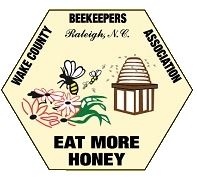 | Wake County Beekeepers Association |
Beekeeping Calendar
Inspections
| January |
Do not disturb the cluster in cold weather. Check for excess moisture |
| February |
Lift hive to estimate stores (do this regularly to notice the range of weights) On a warm day, carefully and quickly check the hive for sufficient food (see nutrition below). Brood build-up should be intensifying if the weather has been warm. |
| March |
If the temperatures are cooperating (above 60 degrees) there be no problem removing the frames for a quick inspection – look for disease laying pattern. Gage size of cluster vs food stores Watch for signs of swarming (e.g. queen cups) 1st Mite Check, possibly 1st treatment needed. |
| April |
Do a complete inspection (warm and still day). Queen right? Plenty of eggs and brood? Nice laying pattern? Pay attention to brood pattern, replace queen if necessary Watch out for swarming. |
| May |
Inspect the hive weekly. Have a plan before opening the hive. Record observations Mite checks for any that were not yet treated. Check supers, move less full frames in, fuller frames out |
| June |
Inspect the hives weekly to make certain the hives are healthy and the queen is there doing her job. Watch for nectar to slow down. Check supers, move less full frames in, fuller frames out |
| July |
Inspections should be quick to limit robbing risk Check supers, move less full frames in, fuller frames out Right-size the number of brood boxes and keep to a minimum based on colony population. Mite check for all colonies not yet treated. |
| August |
Inspections should be quick to limit robbing risk Assessing queen performance is critical. Re- queen if required (requires mated queen) Watch for excessive hive beetle populations Watch for wax moth signs |
| September |
Continue to check on queen performance. Watch for excessive hive beetle populations Watch for wax moth signs |
| October |
Limit inspections Hive beetle population should decrease and be less pressure on healthy colonies. Check for excess moisture, condensation under inner cover |
| November |
Check for excess moisture, condensation under inner cover |
| December |
No peeking. Opening the hive this month could injure your girls. Check for excess moisture Deadouts are high this month as first cold weather arrives. Colonies without large populations of healthy bees will not survive cold nights. |
